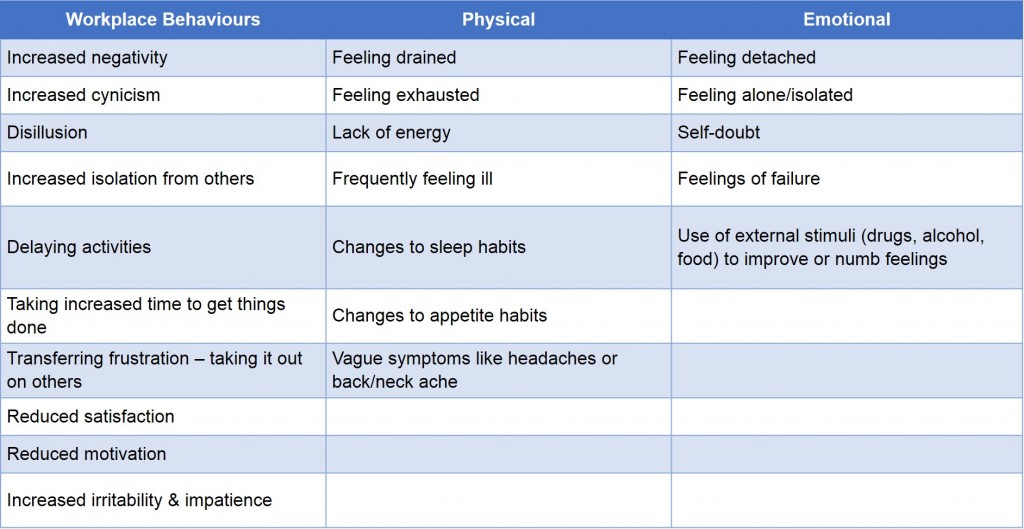How to Recognise Burnout and Avoid it!

I recently read an article about burnout. It seems that 1 in 3 of us are struggling to cope at work because of stress, depression or burnout. That’s a LOT of people. And a LOT of time spent struggling.
In this post I want to take a closer look at occupational (or job) burnout. We’ll take a look at what the real life signs & symptoms are, understand the risks, and – most importantly – identify how you can avoid or recover from it.
What is burnout?
Words like “stress”, “depression” and “burnout” seem to be bandied around like sweets these days. I don’t know about you, but at least once a day I overhear someone say something along the lines of “oh, I’m so stressed” or “I’m having an awful day, I’m totally depressed”. Now, I’m not saying those people aren’t having a difficult or challenging day, but it does appear that these days we are quick to apply such significant terms to situations and feelings that perhaps – in all truthfulness – aren’t actually stress, depression or burnout.
So, what’s the difference between a series of tough days and burnout?
Dr Freudenberger explained the phrase back in the 1980’s in his book Burn-Out: The High Cost of Achievement:
If you have ever seen a building that has been burned out, you know it’s a devastating sight. What had once been a throbbing, vital structure is now deserted. Where there had once been activity, there are now only crumbling reminders of energy and life. Some bricks or concrete may be left; some outline of windows. Indeed, the outer shell may seem almost intact. Only if you venture inside will you be struck by the full force of the desolation.
I don’t know about you, but I read that description and recognised it immediately. That’s one hell of a description to recognise in terms of your own life and where you’ve been (or currently are – which might be the case for some of you reading this). If you also recognise Freudenberger’s description – or if it’s stirring some signs of recognition in you – then please don’t despair. That recognition could be the turning point in your situation and the start of your own personal liberation.
So, what does burnout look like?
In a real-world setting, Freudenberger’s description could look like this:

I imagine many of those signs would also be around if you were feeling stressed or depressed. So how would you know whether you were burned out as well?
The Risk Factors for Burnout
I believe it’s the risk factors which make the difference (keep in mind I’m not an expert here!). I’ve been stressed and I’ve been depressed. But when you can also tick off some of the risk factors for burnout… I’d say that’s the difference.
The risk factors for burnout come in two main categories. One is internal (i.e. the risks are due to someone’s personality & personal characteristics etc) and the other is external (i.e. the risks are to do with the job & the workplace etc). Here are a few to illustrate the type of thing we’re looking at:
Internal Traits
- Strongly motivated, dedicated people who are “highly involved in the work in which they partake” are more vulnerable to burnout. Wiki suggests this is because the desire of these individuals to achieve stretching goals & expectations “collides with the physical, emotional and mental exhaustion resulting from an inability to achieve them”.
- Individuals with high expectations of themselves – perfectionists.
- Individuals who have a high need for control over work and maintain tasks with themselves.
External Factors
Role related issues:
- Lack of control over resources to achieve your work, or influencing factors that impact your role/job.
- Being under-utilised or unchallenged.
- Incompatible demands making completion of all tasks impossible.
- Lack of recognition or feedback.
- Unclear expectations of the role or from your manager.
- Impossible activities (i.e. tasks that have no conclusion or are impossible to resolve).
Workplace issues:
- Chaotic. highly-pressured or bureaucratic environment.
- Critical Manager.
- Flawed dynamics (including bullying, micromanaging, lack of direction etc).
Lifestyle:
- Poor work-life balance.
- Lack of supportive relationships.
- Lack of sleep.
Do you recognise any of these?
How can I avoid it?
You might already be in a position where you don’t feel burnout or recognise any of the internal or external risk factors associated with it. However, if you do recognise some of those risks above and are wanting to understand what you can do to help side-step it, then here are a few things which might help:
- Put a support system into place – people you can speak to, in a safe and confidential environment, about any of the issues you might be facing or any concerns you might have.
- Take advantage of any work-based support that’s available, which might include an employee assistance programme.
- Balance out your work/life time and ensure you’re doing things you love with people you like as much as you’re working.
- Review your situation and understand your options. This could be anything from discussing your working day with your Line Manager to re-emphasise the “cut-off points” (if work/life balance is an issue) or agree more defined Key Work Objectives (if vagueness of role & expectation is an issue). Work with your employer to address the risk factors you’ve identified.
- Consider what you could do to adjust your approach and proactively challenge or counteract some of the signs you’re seeing. For example, if you recognise yourself being negative or cynical, try to hold back and reframe your comment or concern into a positive – you’ll find that positively-framed comments will gradually help you feel more positive.
- Invest in strengthening your stress management and personal resilience approach. Both will help you feel more in control over your feelings and response to the things that are impacting you.
- Create cut-off points and times around your work commitments and ensure that work doesn’t encroach into your private life.
- Look after yourself by eating healthily, exercising regularly and sleeping well.
How can I reverse the effects?
If you believe you’re currently in full-blown burnout mode then, in addition to the above (which you may or may not be in a position to follow), try the following:
- Time out – If possible, take some time out of the situation to recover and heal. This will also give you time to review the situation from a different perspective (rather than from being within the situation), further helping you to review your options (as per the section above). If you can’t take time out then put on the brakes – you’ve probably been run ragged for quite some time now and would benefit greatly (both emotionally and physically) from slowing down.
- Support – I once read that when we’re at our lowest ebb in the workplace, the first thing we tend to do is cut off our support – and if you reflect on it, you might find out that’s the case. Perhaps you’ve stopped going for coffee with your trusted colleague or have inadvertently isolated yourself from your partner because you’re always working or preoccupied with work-related thoughts. If that’s the case, now is the time to re-establish that support network – it’s vital that you have a trusted network around you to provide you with support. It’s important that you have someone you can speak to in confidence about what’s on your mind and the issues which are causing you issues; someone you can pour everything out to and not worry about them judging what your saying or breaching your confidentiality.
- External Change – As per the section above, discuss the situation with your manager. Outline the situation you’ve faced in terms of the risks, be open about the signs you’re seeing and have an open & honest discussion about what you need or what you’d like to see happen. It might be that you renegotiate your role entirely or ask that all the risks that can be influenced are influenced for the better by your manager.
- Internal Change – As part of your discussion with your manager, you might want to discuss work-based support in addressing any internal risks (such as control or perfectionism) or resilience techniques (e.g. managing stress etc). Also take the opportunity to consider this…
Burnout is an undeniable sign that something important in your life is not working. Take time to think about your hopes, goals, and dreams. Are you neglecting something that is truly important to you? Burnout can be an opportunity to rediscover what really makes you happy and to change course accordingly. HelpGuide
If you’re experiencing burnout right now, please don’t suffer in silence. Reach out and make a change – that change could be anything from seeking help or taking some of the avoidance or recovery steps – but please reach out. Things will change and things will improve. And, most importantly, you will get through this.
You are an amazing person! Don’t forget that 🙂
Learn more:
If you want to find out more about Job Burnout, check out these resources. Please note, I’m not affiliated with these in any way and cannot vouch for their accuracy.
Job Burnout: How to Spot it & Take Action